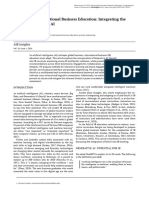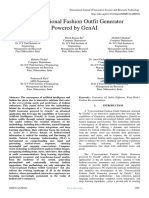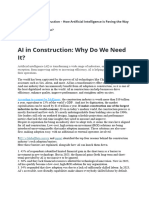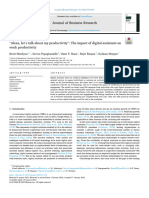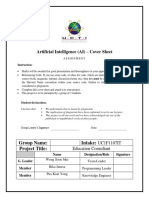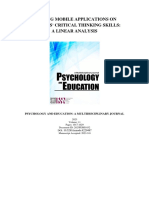Professional Documents
Culture Documents
Generative AI Project Assistant
Generative AI Project Assistant
Copyright
Available Formats
Share this document
Did you find this document useful?
Is this content inappropriate?
Report this DocumentCopyright:
Available Formats
Generative AI Project Assistant
Generative AI Project Assistant
Copyright:
Available Formats
Volume 9, Issue 4, April – 2024 International Journal of Innovative Science and Research Technology
ISSN No:-2456-2165 https://doi.org/10.38124/ijisrt/IJISRT24APR1167
Generative AI Project Assistant
V.Manikandan
Department of Computer Science and Engineering,
Kalasalingam Academy of Research and Institution
Anand Nagar, Krishnankoil, Tamilnadu.
Giridhar Reddy G Nishitha V
Department of Computer Science and Engineering, Department of Computer Science and Engineering,
Kalasalingam Academy of Research and Institution Kalasalingam Academy of Research and Institution
Anand Nagar, Krishnankoil, Tamilnadu Anand Nagar, Krishnankoil, Tamilnadu
Ganga Hemalatha K Kavitha C
Department of Computer Science and Engineering, Department of Computer Science and Engineering,
Kalasalingam Academy of Research and Institution Kalasalingam Academy of Research and Institution
Anand Nagar, Krishnankoil, Tamilnadu Anand Nagar, Krishnankoil, Tamilnadu
Abstract:- Our cutting-edge Generative AI project At its essence, the Generative AI Project Assistant acts
assistant serves as a versatile tool aiding users in as a virtual companion, seamlessly integrating into project
generating data across various applications. Harnessing workflows to offer indispensable assistance throughout the
the latest technologies such as Langchain, OpenAI, and project lifecycle. Through advanced algorithms and machine
Google Colab Face, it ensures superior performance. learning, it distills vast data and historical insights into
We're elevating its capabilities by integrating voice actionable recommendations. Its natural language processing
assistance, enabling seamless interaction in both text and fosters intuitive communication and collaboration, fostering
voice formats. This endeavor involves leveraging a suite cohesive teamwork. A notable strength lies in its capacity to
of tools tailored for the purpose. automate mundane tasks and streamline administrative
processes, freeing up time for strategic initiatives. From
The Generative AI Project Assistant represents a scheduling meetings to tracking milestones, it provides real-
groundbreaking approach to project management, time oversight and facilitates informed decision-making.
integrating generative AI to streamline processes. By Moreover, the assistant evolves alongside the project
employing sophisticated algorithms, it automates tasks, ecosystem, learning from feedback loops to enhance
fosters collaboration, and provides valuable insights. predictive capabilities. As organizations embrace digital
Utilizing natural language processing and machine transformation, the Generative AI Project Assistant emerges
learning, it delivers intelligent suggestions, anticipates as a catalyst for efficiency, innovation, and success in project
challenges, and facilitates the creation of customized management's evolving landscape.
solutions. In essence, this assistant redefines project
management, offering an intuitive, adaptable, and Tom Freston is credited with saying ‘‘Innovation is
efficient platform for teams to achieve their objectives taking two things that exist and putting them together in a
with Chat GPT's prowess at its core. new way’’. For a long time in history, it has been the
prevailing assumption that artistic, creative tasks such as
I. INTRODUCTION writing poems, creating software, designing fashion, and
composing songs could only be performed by humans. This
In the current fast-paced and dynamic business assumption has changed drastically with recent advances in
environment, effective project management demands artificial intelligence (AI) that can generate new content in
heightened coordination, collaboration, and adaptability to ways that cannot be distinguished anymore from human
overcome myriad challenges and uncertainties. Enter craftsmanship. The term generative AI refers to
Generative AI Project Assistants—a paradigm-shifting computational techniques that are capable of generating
advancement in project conceptualization, execution, and seemingly new, meaningful content such as text, images, or
optimization. These assistants leverage artificial intelligence audio from training data. The widespread diffusion of this
to reimagine traditional project management methodologies, technology.
furnishing a comprehensive toolkit to bolster productivity
and decision-making processes. With examples such as Dall-E 2, GPT-4, and Copilot is
currently revolutionizing the way we work and communicate
with each other. Generative AI systems can not only be used
for artistic purposes to create new text mimicking writers or
IJISRT24APR1167 www.ijisrt.com 1253
Volume 9, Issue 4, April – 2024 International Journal of Innovative Science and Research Technology
ISSN No:-2456-2165 https://doi.org/10.38124/ijisrt/IJISRT24APR1167
new images mimicking illustrators, but they can and will preferences to provide personalized and relevant information
assist humans as intelligent question-answering systems. and guidance.
Here, applications include information technology (IT) help
desks where generative AI supports transitional knowledge II. LITERATURE REVIEW
work tasks and mundane needs such as cooking recipes and
medical advice. Industry reports suggest that generative AI "Generative Adversarial Networks", Ian J. Goodfellow et
could raise global gross domestic product (GDP) by 7% and al.. June 2022,
replace 300 million jobs of knowledge workers (Goldman This paper introduces Generative Adversarial Networks
Sachs 2023). (GANs), a framework for training generative models via
adversarial training, sparking numerous advancements in
Undoubtedly, this has drastic implications not only for generative modeling.
the Business & Information Systems Engineering (BISE)
community, where we will face revolutionary opportunities, "Unsupervised Representation Learning with Deep
but also challenges and risks that we need to tackle and Convolutional Generative Adversarial Networks", Alec
manage to steer the technology and its use in a responsible Radford et al., November 2021.
and sustainable direction. In this Catchword article, we Proposes DCGAN, a variant of GANs employing deep
provide a conceptualization of generative AI as an entity in convolutional networks, demonstrating improved image
socio-technical systems and provide examples of models, generation quality and stability.
systems, and applications. Based on that, we introduce
limitations of current generative AI and provide an agenda "Improved Techniques for Training GANs", Tim Salimans
for BISE research. Previous papers discuss generative AI et al., June 2021
around specific methods such as language models (e.g., Addresses challenges in GAN training, introducing
Teubner et al. 2023; Dwivedi et al. 2023; Scho¨bel et al. techniques such as feature matching and minibatch
2023) or specific applications such as marketing (e.g., Peres discrimination to stabilize training and improve generation
et al. 2023), innovation management (Burger et al. 2023), quality.
scholarly research (e.g., Susarla et al. 2023; Davison et al.
2023), and education (e.g., Kasneci et al. 2023; Gimpel et al. "Progressive Growing of GANs for Improved Quality,
2023). Different from these works, we focus on generative AI Stability, and Variation", Tero Karras et al., October
in the context of information systems, and, to this end, we 2020
discuss several opportunities and challenges that are unique Introduces Progressive GANs, a framework for training
to the BISE community and make suggestions for impactful GANs progressively to generate high-resolution images with
directions for BISE research. better quality, stability, and diversity.
Automation: AI can take over repetitive and tedious "BigGAN: Large Scale Generative Adversarial
tasks that consume a lot of time and resources, such as data Networks", Andrew Brock et al. , December 2019
entry, report generation, and scheduling. By automating these Presents BigGAN, a GAN architecture capable of
tasks, AI frees up project managers to focus on more strategic generating high-quality images with better diversity and
and creative aspects of their projects. Moreover, AI can also scalability, leveraging techniques like class-conditional
use machine learning to learn from past data and predict training and truncated noise.
future scenarios, such as project duration, budget, and
resource needs. This can help project managers plan ahead, "StyleGAN: A Style-Based Generator Architecture for
avoid delays, and optimize resource allocation. Generative Adversarial Networks", Tero Karras et al.,
February 2019
Analytics: AI can leverage big data to provide deeper Introduces StyleGAN, which enables explicit control
and more accurate insights into project performance. AI- over image style and diversity through disentangled latent
powered analytics tools can collect and analyze data from representations, leading to state-of-the-art results in image
various sources, such as project documents, team synthesis.
communication, stakeholder feedback, and external factors.
These tools can then identify patterns, trends, and anomalies "Attentional Generative Adversarial Networks for
that might otherwise go unnoticed by human eyes. These Autonomous Driving", Mahdi Ghasemi et al., Sebtember
insights can help project managers monitor progress, identify 2020
risks, opportunities, and areas for improvement, and make Utilizes attention mechanisms in GANs for autonomous
data-driven decisions. driving tasks, improving the model's ability to generate
realistic and diverse driving scenes, contributing to safer
Assistance: AI can also act as a virtual assistant that can autonomous vehicle development.
support project managers in various ways. For example, AI
assistants can generate progress reports, send reminders, "Bias Correction for Generative Adversarial Networks",
answer questions, and provide suggestions based on natural Bingchen Liu et al., April 2021
language processing. These assistants can also facilitate Addresses biases in GAN-generated samples, proposing
communication and collaboration among team members by a method to correct biases by learning and manipulating
creating chat groups, sharing files, and scheduling meetings. latent space representations, enhancing the fairness and
These assistants can also learn from user feedback and diversity of generated content.
IJISRT24APR1167 www.ijisrt.com 1254
Volume 9, Issue 4, April – 2024 International Journal of Innovative Science and Research Technology
ISSN No:-2456-2165 https://doi.org/10.38124/ijisrt/IJISRT24APR1167
implementation of sophisticated algorithms and machine
"Meta-Learning Generative Adversarial Networks", Ting learning models. This stage involves crafting algorithms
Chen et al., January 2022 for natural language processing, sentiment analysis,
Introduces MetaGAN, a meta-learning framework for predictive analytics, and recommendation systems
GANs, enabling fast adaptation to new tasks with limited tailored precisely to the identified requirements and
data by leveraging meta-learning techniques, thereby objectives.
enhancing the versatility and efficiency of generative models. Prototype Development: With algorithms in place, a
prototype version of the Generative AI Project Assistant
"Energy-Based Generative Adversarial Networks", Yunhe is crafted, integrating core functionalities and user
Wang et al., March 2022 interfaces. Through iterative testing and refinement
Presents EBGANs, a variant of GANs utilizing energy- cycles, stakeholders provide feedback, identify usability
based models for training, offering improved stability and concerns, and suggest enhancements.
convergence properties, leading to better sample quality and Integration and Deployment: Upon achieving satisfactory
diversity in generated data.. performance and usability, the prototype integrates
seamlessly with existing project management tools and
III. METHODOLOGY systems. This phase involves configuring access controls,
user permissions, and data privacy measures to ensure
The methodology for developing and implementing the secure interoperability and data exchange.
Generative AI Project Assistant is structured across various Training and Knowledge Transfer: Comprehensive
pivotal stages, all aimed at ensuring resilience, efficacy, and training sessions and user documentation accompany the
a design centered around user needs: introduction of the Generative AI Project Assistant to
Requirement Analysis: This initial phase entails a project management teams. These sessions familiarize
thorough examination of project management users with features, functionalities, and best practices,
stakeholders' requirements and objectives, encompassing facilitating effective utilization.
project managers, team members, and organizational Monitoring and Maintenance: Post-deployment,
leaders. Through interviews, surveys, and workshops, continuous monitoring and maintenance are pivotal to
pain points, challenges, and desired functionalities are ensure optimal performance, scalability, and reliability.
meticulously identified. This entails tracking system metrics, analyzing user
Data Collection and Processing: Following requirement feedback, and addressing any issues or bugs through
definition, the focus shifts to gathering pertinent data regular software updates and patches.
sources, including historical project data, task lists,
communication logs, and team member profiles. These By adhering to this structured methodology,
data sets undergo meticulous processing and structuring organizations can effectively develop, deploy, and leverage
via data preprocessing techniques, ensuring uniformity, the Generative AI Project Assistant to enhance efficiency,
precision, and usability. collaboration, and innovation in project management
Algorithm Development: At the core of the Generative AI processes.
Project Assistant lies the development and
Fig 1: Architecture of Proposed Methodology
IJISRT24APR1167 www.ijisrt.com 1255
Volume 9, Issue 4, April – 2024 International Journal of Innovative Science and Research Technology
ISSN No:-2456-2165 https://doi.org/10.38124/ijisrt/IJISRT24APR1167
The underlying training procedures vary greatly data is crucial. The assistant's adaptability to changing
across different generative AI models (see Fig. 2). For dynamics enhances its reliability.
example, generative adversarial networks (GANs) are Integration and System Compatibility: Assessing
trained through two competing objectives (Goodfellow et seamless integration with existing tools ensures smooth
al. 2014), where one is to create new synthetic samples data flow. Identifying compatibility issues and
while the other tries to detect synthetic samples from the addressing performance bottlenecks optimizes system
actual training samples, so that the distribution of synthetic integration.
samples is eventually close to the distribution of the Ethical and Privacy Considerations Discussion: Ethical
training samples. Differently, systems such as examination includes considerations like data privacy,
ChatGPTbased conversational models use reinforcement security, and confidentiality. Addressing topics such as
learning from human feedback (RLHF). RLHF as used by data ownership and compliance with regulations builds
ChatGPT proceeds in three steps to first create trust and mitigates risks.
demonstration data for prompts, then to have users rank the
quality of different outputs for a prompt, and finally to Overall, the experimental results and discussions
learn a policy that generates desirable output via provide actionable insights into the assistant's performance,
reinforcement learning so that the output would score well usability, and impact on project management. By
during ranking (Ziegler et al. 2019). addressing strengths and weaknesses, organizations can
utilize the assistant to foster collaboration, streamline
A GAN is a class of neural network architecture with workflows, and achieve project success.
a custom, adversarial learning objective (Goodfellow et al.
2014). A GAN consists of two neural networks that contest
with each other in the form of a zero-sum game, so that
samples from a specific distribution can be generated.
Formally, the first network G is called the generator, which
generates candidate samples. The second network D is
called the discriminator, which evaluates how likely the
candidate samples come from a desired distribution.
Thanks to the adversarial learning objective, the generator
learns to map from a latent space to a data distribution of
interest, while the discriminator distinguishes candidates
produced by the generator from the true data distribution
IV. EXPERIMENTAL RESULTS AND
DISCUSSION
The assessment of the Generative AI Project Assistant
encompasses an array of evaluations, focusing on its
performance, user acceptance, and influence on project
management procedures. Here's a comprehensive Fig 2: Chat Screen
breakdown of potential components:
Performance Evaluation: Quantitative metrics such as
task completion time, prediction accuracy, and
reduction in manual effort serve as benchmarks for
assessing the assistant's effectiveness. Comparative
analyses against traditional methods or alternative AI
assistants offer insights into its efficiency.
User Acceptance and Satisfaction: User surveys,
interviews, and usability tests provide valuable
feedback on acceptance and satisfaction. Evaluating
ease of use, usefulness of recommendations, and overall
user experience aids in identifying areas for
enhancement.
Impact on Productivity and Collaboration: Tracking
KPIs like project completion rates and meeting
deadlines before and after implementing the assistant
reveals its impact. Qualitative feedback from
stakeholders sheds light on communication
effectiveness and decision-making processes.
Predictive Analytics Accuracy: If predictive analytics is
a component, evaluating its accuracy in forecasting
project outcomes and identifying risks against actual Fig 3: Voice Screen
IJISRT24APR1167 www.ijisrt.com 1256
Volume 9, Issue 4, April – 2024 International Journal of Innovative Science and Research Technology
ISSN No:-2456-2165 https://doi.org/10.38124/ijisrt/IJISRT24APR1167
GAN Model in AI discriminator correctly classifying fake samples
Generative Adversarial Networks (GANs) are a class (generator loss), while the discriminator aims to
of generative models within the field of Generative AI that maximize this probability (discriminator loss).
have gained significant attention and popularity since their Sample Generation: Once trained, the generator can be
introduction by Ian Goodfellow and his colleagues in 2014. used to generate new data samples by feeding random
GANs are composed of two neural networks: a generator noise through the network. These generated samples
and a discriminator, which are trained simultaneously often exhibit similar characteristics and patterns as the
through an adversarial process. training data but are entirely synthetic.
Generator: The generator network takes random noise as Significance of GANs in Generative AI: High-Quality
input and learns to generate synthetic data samples, such Data Generation: GANs have demonstrated remarkable
as images, text, or audio, that resemble real data from the capabilities in generating high-quality, realistic data
training set. samples across various domains, including images, text,
Discriminator: The discriminator network, on the other and audio.
hand, learns to distinguish between real data samples Unsupervised Learning: GANs enable unsupervised
from the training set and fake samples generated by the learning, where the model learns to represent the
generator. underlying distribution of the training data without
Adversarial Training: During training, the generator explicit labels or supervision.
aims to produce data samples that are indistinguishable Creative Applications: GANs have been applied in
from real ones, while the discriminator aims to correctly numerous creative applications, such as image synthesis,
classify real and fake samples. This results in a min-max style transfer, text generation, and even generating music
game where the generator and discriminator are in and art.
competition with each other, hence the term Data Augmentation: GANs can be used for data
"adversarial." augmentation, where synthetic data generated by the
Training Dynamics: As the generator improves at model is used to augment the training dataset, leading to
generating realistic samples, the discriminator's task improved generalization and robustness of machine
becomes harder, and vice versa. This adversarial learning models.
feedback loop drives both networks to improve over Adversarial Defense: GANs have also been used for
time. adversarial defense, where they are employed to
Loss Function: The training process is typically generate adversarial examples to test the robustness of
formulated as a minimax optimization problem, where machine learning models against adversarial attacks.
the generator aims to minimize the probability of the
Fig 4: GAN Model
Here is how Generative AI can help in SDLC stages (we may see more use cases as Generative AI matures). Overall, we want
to treat Generative AI as senior developer/architect with more accessibility.
IJISRT24APR1167 www.ijisrt.com 1257
Volume 9, Issue 4, April – 2024 International Journal of Innovative Science and Research Technology
ISSN No:-2456-2165 https://doi.org/10.38124/ijisrt/IJISRT24APR1167
Fig 5: Generative AI in SDLC
Define Project Goals and Objectives: Clearly articulate Identify Target Audience and Use Cases: Understand
the goals and objectives of the Generative AI project. the target audience for the Generative AI and identify
Determine what specific tasks or functionalities the key use cases where it can provide value. Consider
Generative AI will perform and how it will benefit industries, domains, or user scenarios where generative
users. capabilities can make a significant impact.
Fig 6: Generative AI strategy
IJISRT24APR1167 www.ijisrt.com 1258
Volume 9, Issue 4, April – 2024 International Journal of Innovative Science and Research Technology
ISSN No:-2456-2165 https://doi.org/10.38124/ijisrt/IJISRT24APR1167
Research and Literature Review: Conduct thorough [4]. Chen, Q., & Wang, C. (2018). "Exploring the Role of
research and literature review on existing Generative AI Artificial Intelligence in Project Management."
techniques, models, and applications. Identify state-of- Journal of Construction Engineering and
the-art approaches, best practices, and potential areas Management, 144(4), 04018006.
for innovation. [5]. Patel, S., & Gupta, R. (2020). "Machine Learning
Data Acquisition and Preprocessing: Gather relevant Techniques for Project Management: A
datasets for training the Generative AI models. Ensure Comprehensive Survey." IEEE Transactions on
the data is clean, diverse, and representative of the Engineering Management, 67(3), 697-710.
target domain. Preprocess the data as necessary to [6]. Johnson, M., & Williams, K. (2021). "Enhancing
prepare it for training. Project Management with Artificial Intelligence:
Model Selection and Architecture Design: Select Opportunities and Challenges." Journal of Systems
appropriate Generative AI models or architectures based and Software, 177, 110921.
on the project goals and requirements. Consider factors [7]. Brown, P., & Clark, R. (2019). "The Impact of
such as scalability, efficiency, and suitability for the Artificial Intelligence on Project Management: A Case
target tasks. Design or customize the model architecture Study Approach." Project Management Journal, 50(4),
as needed. 422-435.
Training and Optimization: Train the Generative AI [8]. Wang, Y., & Li, X. (2018). "Artificial Intelligence and
models using the acquired data. Optimize training Project Management: Opportunities and Challenges."
parameters, such as learning rate, batch size, and International Journal of Project Management, 36(1),
regularization techniques, to ensure optimal 114-123.
performance. Monitor training progress and adjust [9]. Sarker, S., &Sarker, S. (2020). "Artificial Intelligence
parameters as necessary. in Project Management: A Research Agenda."
Evaluation and Validation: Evaluate the performance of Information Systems Frontiers, 22(3), 685-703.
the trained models using appropriate metrics and [10]. Hayes, M., & Nguyen, T. (2019). "The Role of AI in
validation techniques. Assess factors such as generation Project Management: An Exploratory Study." Journal
quality, diversity, coherence, and computational of Management Information Systems, 36(4), 1112-
efficiency. Iterate on the models and training process 1143.
based on evaluation results.
V. CONCLUSION
In summary, the Generative AI Project Assistant
stands as a revolutionary asset in contemporary project
management, seamlessly integrating automation, predictive
analytics, and collaborative functionalities. Its profound
impact on productivity, decision-making, and user
contentment has been clearly demonstrated through
thorough evaluation and analysis. By leveraging the
capabilities of artificial intelligence, this assistant not only
simplifies mundane tasks but also equips project
stakeholders with the insights needed to tackle intricate
challenges decisively. Looking ahead, ongoing refinement,
integration efforts, and a steadfast commitment to ethical
standards will be essential in unlocking the assistant's full
potential and fostering ongoing innovation in project
management methodologies.
REFERENCES
[1]. Smith, J., & Johnson, R. (2021). "Integrating Artificial
Intelligence into Project Management: A Review."
International Journal of Project Management, 39(3),
492-503.
[2]. Jones, A., & Brown, L. (2020). "The Future of Project
Management: AI-Driven Assistants." Project
Management Journal, 51(6), 687-700.
[3]. Li, Y., & Zhang, W. (2019). "Artificial Intelligence
Applications in Project Management: A
Comprehensive Review." Automation in
Construction, 101, 184-198.
IJISRT24APR1167 www.ijisrt.com 1259
You might also like
- PS3000 enDocument12 pagesPS3000 enMadison MadisonNo ratings yet
- Brochure MIT XPRO Designing and Building AI Products and Services 07-July-2021 V9Document15 pagesBrochure MIT XPRO Designing and Building AI Products and Services 07-July-2021 V9ASAD MOLLAHNo ratings yet
- The Impact of DHIS 2 in Kenya - A User PerspectiveDocument12 pagesThe Impact of DHIS 2 in Kenya - A User PerspectiveJames GathogoNo ratings yet
- Reinventing International Business Education Integrating The Power of Generative AiDocument7 pagesReinventing International Business Education Integrating The Power of Generative Aiflavio amayoNo ratings yet
- Full Text 01Document12 pagesFull Text 01fondationibdaaNo ratings yet
- 1.project Management in The Era of Artificial IntelligenceDocument11 pages1.project Management in The Era of Artificial IntelligencemixatshopjoNo ratings yet
- Forward! 1: Artificial Intelligence in ArchitectureDocument24 pagesForward! 1: Artificial Intelligence in ArchitectureBrianNo ratings yet
- Artificial Intelligence: A Computational and Linear Programming ApproachDocument6 pagesArtificial Intelligence: A Computational and Linear Programming ApproachInternational Journal of Innovative Science and Research TechnologyNo ratings yet
- Information Systems For Business and Beyond AssignmentDocument7 pagesInformation Systems For Business and Beyond AssignmentBonnieNo ratings yet
- 51 ArticleText 102 4 10 20200805Document7 pages51 ArticleText 102 4 10 20200805Harshit Kumar SengarNo ratings yet
- Economic Potential of Generative AI - McKinseyDocument21 pagesEconomic Potential of Generative AI - McKinseyabhinl2006100% (1)
- AI in Product InnovationDocument18 pagesAI in Product InnovationDerick cheruyotNo ratings yet
- International Journal of Information ManagementDocument16 pagesInternational Journal of Information Managementrobie bioliNo ratings yet
- Insight AI White PaperDocument17 pagesInsight AI White PapersonskusaNo ratings yet
- MSAENG Volume 2 Issue 2 Pages 628-646Document18 pagesMSAENG Volume 2 Issue 2 Pages 628-646Fadwa KhaledNo ratings yet
- Artificial Intelligence in Business and Future Prospect: October 2021Document5 pagesArtificial Intelligence in Business and Future Prospect: October 2021Eisha MunawarNo ratings yet
- Conversational Fashion Outfit Generator Powered by GenAIDocument5 pagesConversational Fashion Outfit Generator Powered by GenAIInternational Journal of Innovative Science and Research TechnologyNo ratings yet
- Artificial Intelligence Chatbots Are New RecruitersDocument6 pagesArtificial Intelligence Chatbots Are New Recruitersjaimebriz2fakeNo ratings yet
- 1 s2.0 S2667241323000198 MainDocument10 pages1 s2.0 S2667241323000198 MainLevi PadohaNo ratings yet
- Rethinking Cloud Strategies For AIDocument10 pagesRethinking Cloud Strategies For AImontharathNo ratings yet
- Emerging TechnologyDocument2 pagesEmerging Technologyharsel.farrelNo ratings yet
- BC Report SE-22092Document8 pagesBC Report SE-22092HamzaNo ratings yet
- Exploring Opportunities in The Generative Ai Value ChainDocument10 pagesExploring Opportunities in The Generative Ai Value ChainAndreea PironNo ratings yet
- Literature ReviewDocument18 pagesLiterature ReviewTalha EjazNo ratings yet
- Diffusion of Artificial Intelligence in Human Resource Domain With Specific Reference To Recruitment Function A Literature Review StudyDocument8 pagesDiffusion of Artificial Intelligence in Human Resource Domain With Specific Reference To Recruitment Function A Literature Review StudyInternational Journal of Innovative Science and Research TechnologyNo ratings yet
- Emerging Trends in IoT - Rajat & SwarajDocument6 pagesEmerging Trends in IoT - Rajat & Swarajsarthakgurav06No ratings yet
- AI Research ReportDocument13 pagesAI Research ReportVanshika SharmaNo ratings yet
- 165 SiraDocument40 pages165 SiraMarc JacquinetNo ratings yet
- Application of Artificial Intelligence in Automation of Supply Chain ManagementDocument12 pagesApplication of Artificial Intelligence in Automation of Supply Chain ManagementShashwat ShuklaNo ratings yet
- MygradpublicationDocument10 pagesMygradpublicationDouglas T. BrooksNo ratings yet
- Jallow Et Al ECKM Knowledge Management and Artificial Intelligence 2020Document9 pagesJallow Et Al ECKM Knowledge Management and Artificial Intelligence 2020094Shalida AisyahNo ratings yet
- IIT Dehli 21 11 2023 Final 1Document56 pagesIIT Dehli 21 11 2023 Final 1AyushNo ratings yet
- Artificial Intelligence A Study of Automation, and Its Impact On Data ScienceDocument10 pagesArtificial Intelligence A Study of Automation, and Its Impact On Data ScienceEditor IJTSRDNo ratings yet
- AI BrochureDocument18 pagesAI Brochuregyarsilalsolanki011No ratings yet
- 51 ArticleText 102 4 10 20200805Document7 pages51 ArticleText 102 4 10 20200805Om PasalkarNo ratings yet
- Lins2021 Article ArtificialIntelligenceAsAServiDocument16 pagesLins2021 Article ArtificialIntelligenceAsAServiTao Jung WangNo ratings yet
- An Emerging Artificial Intelligence Techniques On Employment and Organisations in The Industrial Working EnvironmentDocument9 pagesAn Emerging Artificial Intelligence Techniques On Employment and Organisations in The Industrial Working EnvironmentIJRASETPublicationsNo ratings yet
- Emerging Technologies in BusinessDocument5 pagesEmerging Technologies in BusinessEditor IJTSRDNo ratings yet
- Exploring The Future Jobs, Working Experience, Ethical Issues and Skills From Artificial Intelligence PerspectiveDocument6 pagesExploring The Future Jobs, Working Experience, Ethical Issues and Skills From Artificial Intelligence PerspectiveInternational Journal of Innovative Science and Research TechnologyNo ratings yet
- Information Master ThesisDocument9 pagesInformation Master ThesisLaiba NoorNo ratings yet
- Jurnal Internasional AI 3Document16 pagesJurnal Internasional AI 3Abib MustofaNo ratings yet
- Alexa, Let's Talk About My ProductivityDocument13 pagesAlexa, Let's Talk About My ProductivityTHIÊN NGUYỄN TRẦN BẢONo ratings yet
- A Survey of Generative AI ApplicationsDocument36 pagesA Survey of Generative AI ApplicationsJoJon DoedNo ratings yet
- Ip2023 07 006Document10 pagesIp2023 07 006Ashutosh MittalNo ratings yet
- Seminar Report 2Document14 pagesSeminar Report 2raut09562100% (1)
- Lpe 2 sp1Document11 pagesLpe 2 sp1AFK MasterNo ratings yet
- Application of Artificial Intelligence in The Nigerian BuildingDocument7 pagesApplication of Artificial Intelligence in The Nigerian Buildingkaren.ngai618No ratings yet
- Project Management Competencies in AI-Driven Environments: A Qualitative AssessmentDocument11 pagesProject Management Competencies in AI-Driven Environments: A Qualitative AssessmentInternational Journal of Innovative Science and Research TechnologyNo ratings yet
- The Potential of Generative Artificial Intelligence Across Disciplines Perspectives and Future DirectionsDocument33 pagesThe Potential of Generative Artificial Intelligence Across Disciplines Perspectives and Future Directionsahmed yasseriNo ratings yet
- International Journal of Information Management Data InsightsDocument8 pagesInternational Journal of Information Management Data InsightsDr. Anushka KulkarniNo ratings yet
- Research Paper - Organizational BehaviourDocument11 pagesResearch Paper - Organizational BehaviourLeeroy ButauNo ratings yet
- AI in BusinessDocument10 pagesAI in BusinessAkshat JainNo ratings yet
- Nitin Liladhar RaneDocument20 pagesNitin Liladhar RanenitinNo ratings yet
- Cmi 2Document7 pagesCmi 2Plamena AleksandrovaNo ratings yet
- Amygda - Building Reusable and Flexible AI ModelsDocument9 pagesAmygda - Building Reusable and Flexible AI ModelsRaviteja ValluriNo ratings yet
- International Journal of Information ManagementDocument16 pagesInternational Journal of Information ManagementdinaNo ratings yet
- From AI To Digital Transformation. The AI Readiness FrameworkDocument28 pagesFrom AI To Digital Transformation. The AI Readiness FrameworkyeeprietoNo ratings yet
- Foundation For AI With Microsoft FabricDocument14 pagesFoundation For AI With Microsoft Fabricvinay.pandey9498No ratings yet
- GenerativeAIforManagers PaperbackDocument106 pagesGenerativeAIforManagers PaperbackJuandresNo ratings yet
- SSRN Id3521915Document5 pagesSSRN Id35219152001blancaNo ratings yet
- Generative AI Transformation Blueprint: Byte-Sized Learning Series, #3From EverandGenerative AI Transformation Blueprint: Byte-Sized Learning Series, #3No ratings yet
- Human Resource Functions: Examining Insights from ABC Research OrganizationDocument9 pagesHuman Resource Functions: Examining Insights from ABC Research OrganizationInternational Journal of Innovative Science and Research TechnologyNo ratings yet
- Conceptualized Fusion Reactor based on Gas Turbine with High Temperature CO2Document7 pagesConceptualized Fusion Reactor based on Gas Turbine with High Temperature CO2International Journal of Innovative Science and Research TechnologyNo ratings yet
- The Expanding Attack Surface: Securing AI and Machine Learning Systems in Security OperationsDocument8 pagesThe Expanding Attack Surface: Securing AI and Machine Learning Systems in Security OperationsInternational Journal of Innovative Science and Research Technology100% (1)
- Personal Capabilities of The Non-Teaching Personnel and Client SatisfactionDocument8 pagesPersonal Capabilities of The Non-Teaching Personnel and Client SatisfactionInternational Journal of Innovative Science and Research TechnologyNo ratings yet
- The Impact of the Commercial Agriculture Credit Scheme (CACS) on the Agricultural Economy of Nigeria and its Total Output (2015-2019)Document8 pagesThe Impact of the Commercial Agriculture Credit Scheme (CACS) on the Agricultural Economy of Nigeria and its Total Output (2015-2019)International Journal of Innovative Science and Research TechnologyNo ratings yet
- Teacher-Induced Academic Stress: Predicting Eating Behavior Problems in College StudentsDocument8 pagesTeacher-Induced Academic Stress: Predicting Eating Behavior Problems in College StudentsInternational Journal of Innovative Science and Research TechnologyNo ratings yet
- Modern Approaches to Sustainable AgricultureDocument10 pagesModern Approaches to Sustainable AgricultureInternational Journal of Innovative Science and Research Technology100% (1)
- Integrating Quantum Algorithms with Gravitational-Wave Metrology for Enhanced Signal DetectionDocument18 pagesIntegrating Quantum Algorithms with Gravitational-Wave Metrology for Enhanced Signal DetectionInternational Journal of Innovative Science and Research Technology100% (1)
- Utilizing Chicken Eggshells and Waste Glass Powder as Cement Fillers for Environmental StabilityDocument6 pagesUtilizing Chicken Eggshells and Waste Glass Powder as Cement Fillers for Environmental StabilityInternational Journal of Innovative Science and Research TechnologyNo ratings yet
- The Impact of Termite Activity on the Availability of Soil Micronutrients in Tropical RegionsDocument6 pagesThe Impact of Termite Activity on the Availability of Soil Micronutrients in Tropical RegionsInternational Journal of Innovative Science and Research Technology100% (1)
- Assessment of Integrated Poultry Manure and Synthetic Fertilizer Effects on Maize (Zea mays) Growth and Soil Properties: A Study from Bayero University, KanoDocument15 pagesAssessment of Integrated Poultry Manure and Synthetic Fertilizer Effects on Maize (Zea mays) Growth and Soil Properties: A Study from Bayero University, KanoInternational Journal of Innovative Science and Research Technology100% (1)
- Study of prevalence of Head Lice (Pediculus Humanus Capitis) Among Schoolchildren in the Zawiya Region, LibyaDocument10 pagesStudy of prevalence of Head Lice (Pediculus Humanus Capitis) Among Schoolchildren in the Zawiya Region, LibyaInternational Journal of Innovative Science and Research Technology0% (1)
- Transforming Challenges to Victories: An Inquiry on Transformational Leadership of School Leaders in the Public Elementary SchoolsDocument54 pagesTransforming Challenges to Victories: An Inquiry on Transformational Leadership of School Leaders in the Public Elementary SchoolsInternational Journal of Innovative Science and Research TechnologyNo ratings yet
- Meta Land: Redefining Virtual Communities Through Centralized Governance, Inclusivity and InnovationDocument5 pagesMeta Land: Redefining Virtual Communities Through Centralized Governance, Inclusivity and InnovationInternational Journal of Innovative Science and Research TechnologyNo ratings yet
- Development of Smart Ground Fault Location Model For Radial Distribution SystemDocument14 pagesDevelopment of Smart Ground Fault Location Model For Radial Distribution SystemInternational Journal of Innovative Science and Research TechnologyNo ratings yet
- Solar Based Multilevel Inverter F o R BLDC Motor DriveDocument8 pagesSolar Based Multilevel Inverter F o R BLDC Motor DriveInternational Journal of Innovative Science and Research TechnologyNo ratings yet
- Design and Development of Multi-Featured Medical StretcherDocument4 pagesDesign and Development of Multi-Featured Medical StretcherInternational Journal of Innovative Science and Research TechnologyNo ratings yet
- The Influence of Continuance Commitment on Job Satisfaction of Barangay Health Workers in Malaybalay City, BukidnonDocument14 pagesThe Influence of Continuance Commitment on Job Satisfaction of Barangay Health Workers in Malaybalay City, BukidnonInternational Journal of Innovative Science and Research TechnologyNo ratings yet
- Seasonal Variation and Distribution Patterns of Endophytic Community in Withania SomniferaDocument7 pagesSeasonal Variation and Distribution Patterns of Endophytic Community in Withania SomniferaInternational Journal of Innovative Science and Research TechnologyNo ratings yet
- Exploring The Potential Advantages of Traditional Therapies in Autoimmune Blistering Illnesses: A Comprehensive Review and Analysis, ResearchDocument12 pagesExploring The Potential Advantages of Traditional Therapies in Autoimmune Blistering Illnesses: A Comprehensive Review and Analysis, ResearchInternational Journal of Innovative Science and Research TechnologyNo ratings yet
- Intelligent Clinical Documentation: Harnessing Generative AI For Patient-Centric Clinical Note GenerationDocument15 pagesIntelligent Clinical Documentation: Harnessing Generative AI For Patient-Centric Clinical Note GenerationInternational Journal of Innovative Science and Research TechnologyNo ratings yet
- Strategic Deployment of Ducklink Wireless Devices For Disaster Mitigation and Management in Nueva ECIJA University of Science and Technology Sumacab CampusDocument13 pagesStrategic Deployment of Ducklink Wireless Devices For Disaster Mitigation and Management in Nueva ECIJA University of Science and Technology Sumacab CampusInternational Journal of Innovative Science and Research TechnologyNo ratings yet
- Skin Disease Detection and Remedial SystemDocument7 pagesSkin Disease Detection and Remedial SystemInternational Journal of Innovative Science and Research TechnologyNo ratings yet
- Application of Plant Growth Promoting Rhizobacteria On Vegetative Growth in Chili Plants (Capsicum Frutescens L.)Document7 pagesApplication of Plant Growth Promoting Rhizobacteria On Vegetative Growth in Chili Plants (Capsicum Frutescens L.)International Journal of Innovative Science and Research TechnologyNo ratings yet
- Reading Intervention Through "Brigada Sa Pagbasa": Viewpoint of Primary Grade TeachersDocument3 pagesReading Intervention Through "Brigada Sa Pagbasa": Viewpoint of Primary Grade TeachersInternational Journal of Innovative Science and Research TechnologyNo ratings yet
- Unlocking Sentiments: Enhancing IOCL Petrol Pump ExperiencesDocument8 pagesUnlocking Sentiments: Enhancing IOCL Petrol Pump ExperiencesInternational Journal of Innovative Science and Research TechnologyNo ratings yet
- EmoConnect: Nurturing Trust and Relationship Bonds in Alzheimer's ConversationsDocument3 pagesEmoConnect: Nurturing Trust and Relationship Bonds in Alzheimer's ConversationsInternational Journal of Innovative Science and Research TechnologyNo ratings yet
- Fall Detection and Boundary Detection in Care HomesDocument7 pagesFall Detection and Boundary Detection in Care HomesInternational Journal of Innovative Science and Research TechnologyNo ratings yet
- Smart and Secure Home With ChatbotDocument9 pagesSmart and Secure Home With ChatbotInternational Journal of Innovative Science and Research TechnologyNo ratings yet
- Preparation and Identification of Magnetic Iron Nanoparticle Based On A Natural Hydrogel and Its Performance in Targeted Drug DeliveryDocument17 pagesPreparation and Identification of Magnetic Iron Nanoparticle Based On A Natural Hydrogel and Its Performance in Targeted Drug DeliveryInternational Journal of Innovative Science and Research TechnologyNo ratings yet
- 05 Genex Assistant Wcdma (Ver2.3)Document45 pages05 Genex Assistant Wcdma (Ver2.3)Harvinder SinghNo ratings yet
- Ejcn 2010204 ADocument6 pagesEjcn 2010204 ASiti Ika FitrasyahNo ratings yet
- 2005 Evaluating and Improving WebsitesDocument56 pages2005 Evaluating and Improving WebsitesPantazis PastrasNo ratings yet
- Exxon Mobile Case StudyDocument4 pagesExxon Mobile Case StudyShaher ShaikNo ratings yet
- Scooter Lending SRSDocument11 pagesScooter Lending SRSAmar SomaniNo ratings yet
- SERTICA - 7 Challenges in Technical Ship ManagementDocument11 pagesSERTICA - 7 Challenges in Technical Ship ManagementSamuel ChanNo ratings yet
- A GRADE 12 PRACTICAL RESEARCH II Q2M3 Teacher Copy Final LayoutDocument18 pagesA GRADE 12 PRACTICAL RESEARCH II Q2M3 Teacher Copy Final LayoutNessel AuditorNo ratings yet
- Teaching With Moodle: Moodle 4U "Teachers"Document73 pagesTeaching With Moodle: Moodle 4U "Teachers"James VMNo ratings yet
- SummariesDocument15 pagesSummariesibadimran90No ratings yet
- User-Centered Design ApproachDocument5 pagesUser-Centered Design ApproachAnonymous NDs7ZbugNo ratings yet
- Quality Plan For TBS ProjectDocument3 pagesQuality Plan For TBS ProjectLendy GunawanNo ratings yet
- UntitledDocument105 pagesUntitledAkemi XrnozyNo ratings yet
- Unit TestingDocument10 pagesUnit TestingRitesh RaushanNo ratings yet
- Project Report (Rishab)Document44 pagesProject Report (Rishab)Aryan singh The blue gamerNo ratings yet
- SRS Library Management SystemDocument7 pagesSRS Library Management SystemAishwarya NigamNo ratings yet
- CH16Document14 pagesCH16Sabrina Ánh TranNo ratings yet
- Klokbox DesignDocument11 pagesKlokbox DesignMukaram GraphicsNo ratings yet
- Kadai BarashiDocument9 pagesKadai BarashiVladVSENo ratings yet
- User Centred Design Through An Iterative and Incremental ApproachDocument57 pagesUser Centred Design Through An Iterative and Incremental Approachimranporasona100% (1)
- AI DocumentationDocument54 pagesAI DocumentationTan Ming Ho100% (1)
- Employee Leave Management System: FUDMA Journal of Sciences July 2020Document7 pagesEmployee Leave Management System: FUDMA Journal of Sciences July 2020MOHAMMED ASHICKNo ratings yet
- Reading Mobile Applications On Students' Critical Thinking Skills: A Linear AnalysisDocument14 pagesReading Mobile Applications On Students' Critical Thinking Skills: A Linear AnalysisPsychology and Education: A Multidisciplinary JournalNo ratings yet
- Analysis ofDocument15 pagesAnalysis ofDhruv DhIngraNo ratings yet
- AL2 Series SOFTWARE MANUAL Jy992d74001l PDFDocument124 pagesAL2 Series SOFTWARE MANUAL Jy992d74001l PDFFlorin RaduNo ratings yet
- Case Study - PDDocument1 pageCase Study - PDMahdie AlavianNo ratings yet
- FYP Proposal Development NewDocument11 pagesFYP Proposal Development Newsharjeel Ahmed'sNo ratings yet
- Usability Testing Report (ENGLISH Only)Document7 pagesUsability Testing Report (ENGLISH Only)memorphNo ratings yet
- SSDD Template A2Document18 pagesSSDD Template A2Arvind ChariNo ratings yet



